
Have you ever considered what monetary compensation you might be entitled to after an accident?
Personal injury lawsuits filed in the United States in 2024 were at an all-time high, and that is just the beginning of how much people value injury compensation.
However, the settlement amount is not as simple as it sounds. There are many aspects that go into calculating the final payout, and learning about such subtleties may go a long way in your case.
Knowing and leveraging these factors will lead to having proper expectations and, therefore, making the right moves that will lead to fair results.
Here are six critical factors that affect personal injury settlements:
1. Legal Representation

The quality of your legal representation has a substantial impact on the outcome of your settlement. Personal injury attorneys bring expertise and negotiating skills to the table, improving your chances of a reasonable compensation.
Key Considerations:
- Experience: An attorney with a successful track record in personal injury claims will likely obtain a reasonable settlement. Checking testimonies and previous case outcomes might help you make an informed decision.
- Resources: Skilled attorneys frequently collaborate with medical experts, accident reconstruction specialists, and other professionals to improve your case. They may also have access to litigation money, allowing your case to progress without financial constraints.
- Negotiation Skills: Insurance companies want to reduce compensation, so having an experienced attorney who can negotiate effectively is essential. Their ability to counter lowball bids and produce strong proof frequently influences the eventual settlement.
2. Severity of Injuries

The magnitude of your injuries is perhaps one of the strongest determinants of your compensation.
Major injuries take a long time to heal and have an impact on a person’s life, therefore increasing compensation amounts. For this reason, your injuries are compared to how much they prevent you from doing work and other activities. For example, for some of the more chronic severities, namely spinal cord injury and traumatic brain injury, the injuries tend to command higher settlements.
Key Considerations:
- Medical Expenses: Most severe injuries involve treatments, surgeries, physical therapy, and sometimes even continued care. All these costs fall into the calculation when a settlement is being arrived at.
- Impact on Daily Life: If such injuries permanently incapacitate you and cause you to be in severe pain all day or be unable to work anymore, then you will receive higher compensation for the loss of quality of life. Usually, occupational and physical therapists, as well as financial consultants, provide more specific evaluations of career and life’s long-term effects.
- Documentation: When the medical records are detailed, and the specialist witnesses establish the extent of your injuries, it becomes easy to prove that they hurt severely. In addition, frequent visits to doctors and clinicians and having a journal that documents the symptoms should assist in developing your case.
3. Liability and Fault
Another factor on the list is the extent of clarity of liability. Thus, if the other party’s mistake is comprehensible and you have enough evidence, you have a pretty good chance of getting a reasonable settlement.
The determination of clear liability significantly relieves the prospects of long-winded negotiations, which are customary with blurry liability.
Key Considerations:
- Shared Fault: Sometimes, the agreed settlement is cut according to the percentage of blame you bear in the accident. This is called “comparative negligence.”
- Evidence: The proof of liability is photographs, videos, police reports, and statements of witnesses. You stand to gain credibility with your reports by getting the accident videos from the dashcam or at least an explanation from the accident reconstruction specialists.
- Legal Standards: Many kinds of laws are used in regard to shared culpability, such as comparative negligence or contributory negligence. If you want to deal with these things properly, it’s essential to speak to someone who understands the state laws.
4. Economic Damages
Economic damages are the quantifiable financial losses caused by the accident. These include medical expenses, lost pay, and property damage.
Key Considerations:
- Lost Income: If your injuries prevent you from working temporarily or permanently, the settlement will include past and future lost wages. Calculations frequently include missed possibilities for promotion or career progress.
- Property Damage: Any damage to your vehicle or other personal items will also be covered by the settlement. Comprehensive repair estimates and receipts for replacements are essential.
- Receipts and Invoices: Maintaining detailed records of all expenses is critical for showing economic harm. This covers medical charges, transportation fees for treatment, and house modifications for mobility aids or accessibility upgrades.
5. Insurance Policy Limits

The at-fault party’s insurance coverage is a crucial factor in deciding the maximum settlement amount you can receive.
Key Considerations:
- Policy Limits: If the at-fault party’s insurance coverage has a low limit, your payout may be limited to that amount, even if the losses exceed it.
- Uninsured/Underinsured Motorist Coverage: If the at-fault party does not have enough insurance, you may need to use your uninsured/underinsured driver policy. Thoroughly reviewing your insurance and filing claims on time will help you get better results.
- Negotiations: An expert attorney can assist you in negotiating with the insurance company to maximize your reimbursement while remaining within the policy limits. If the damages exceed coverage, one strategy could be to leverage the at-fault party’s other assets.
6. Non-Economic Damages
Non-economic damages pay for intangible losses you’ve endured, such as pain and suffering, mental distress, and diminished enjoyment of life.
Key Considerations:
- Pain and Suffering: The severity of your physical and emotional suffering will be examined, typically with the help of mental health professionals. Journals that document your mental condition, as well as professional perspectives on trauma, can back up these statements.
- Loss of Consortium: If your injuries have interfered with your connection with your spouse or family, you may be entitled to further compensation. Statements from family members and professionals might emphasize the severity of these effects.
- Multiplier Method: In many circumstances, non-economic losses are estimated by multiplying your economic damages by a factor (often 1.5 to 5). Demonstrating the uniqueness of your pain can lead to a greater multiplier.
Conclusion
Several factors influence the settlement amount in personal injury cases, including the severity of your injuries, the at-fault party’s insurance coverage, and the legal team’s skill. Understanding these elements can help you navigate the process and reach a settlement that fairly pays you for your losses.
If you have been hurt and are considering filing a personal injury claim, speak with an expert attorney to ensure your rights are protected and your compensation is maximized. With the appropriate attitude and extensive preparation, you can reach a positive conclusion allowing you to move forward after the accident.



